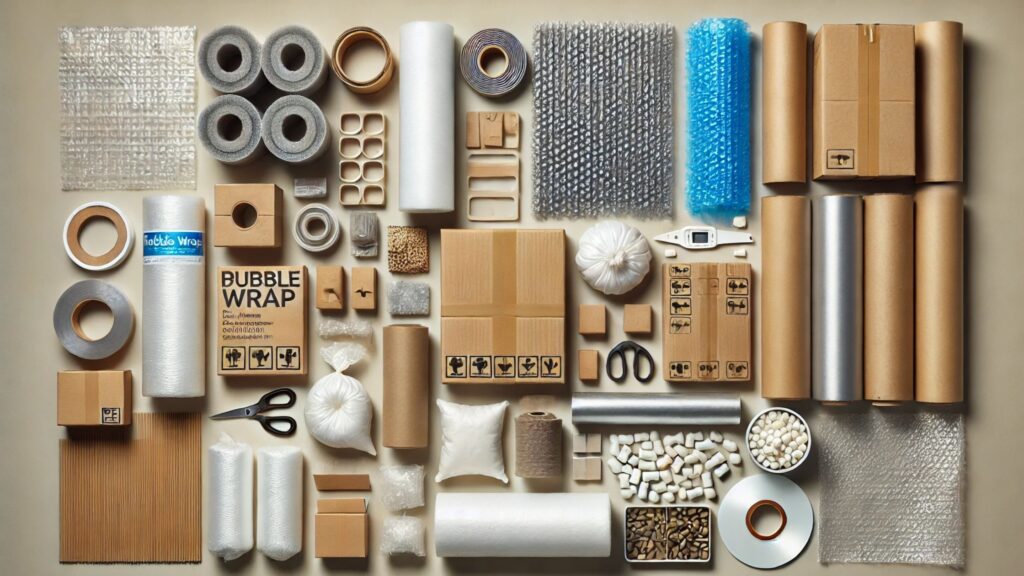Types of Protective Packaging: In the world of shipping and logistics, ensuring that products reach their destination without damage is crucial. Protective packaging plays a significant role in safeguarding items from physical, environmental, and mechanical hazards. Understanding the different types of protective packaging helps businesses choose the right materials to reduce damage, minimize costs, and enhance customer satisfaction. Below are some of the most common protective packaging types and their uses.
Types of Protective Packaging: Essential Guide for Safe Shipping
1. Bubble Wrap
Bubble wrap is one of the most popular and widely used protective packaging materials. It consists of plastic sheets with air-filled bubbles that provide cushioning and shock absorption. It is ideal for fragile items such as electronics, glassware, and ceramics.
2. Foam Packaging
Foam packaging comes in various forms, including foam sheets, foam rolls, and molded foam. This type of protective packaging is excellent for cushioning heavy or delicate items and providing thermal insulation. Common types include polyethylene foam, polyurethane foam, and expanded polystyrene (EPS) foam.
3. Corrugated Cardboard
Corrugated cardboard is a sturdy and versatile packaging material widely used in shipping boxes. It offers excellent structural strength and can be customized with additional padding to enhance protection. Single, double, and triple-wall corrugated boxes provide varying levels of durability depending on the shipping needs.
4. Air Pillows
Air pillows are lightweight, inflatable plastic cushions used to fill empty spaces inside packaging. They prevent movement during transit and help absorb shocks, making them an eco-friendly alternative to traditional packing peanuts.
5. Packing Peanuts
Packing peanuts are small foam pieces that provide cushioning and prevent items from shifting inside a box. They are available in traditional polystyrene as well as biodegradable options, making them a versatile choice for various shipping needs.
6. Edge and Corner Protectors
Edge and corner protectors, typically made of foam, cardboard, or plastic, reinforce the most vulnerable parts of a package. They are especially useful for protecting flat-screen TVs, framed artwork, furniture, and other delicate items.
7. Shrink Wrap
Shrink wrap is a plastic film that tightly covers and secures items when heat is applied. It provides protection against dust, moisture, and tampering, making it suitable for bundling multiple items together or securing products with irregular shapes.
8. Paper-Based Protective Packaging
Paper-based packaging materials, such as kraft paper, shredded paper, and honeycomb paper, offer an eco-friendly cushioning option. These materials are recyclable, biodegradable, and ideal for wrapping delicate items or filling voids in packages.
9. Molded Pulp Packaging
Molded pulp packaging is made from recycled paper and molded into various shapes to protect fragile goods like electronics, food containers, and glass bottles. It is an environmentally friendly alternative to plastic-based protective packaging.
10. Insulated Packaging
For temperature-sensitive products such as pharmaceuticals and perishable food items, insulated packaging provides temperature control. It includes materials like insulated liners, gel packs, and dry ice to maintain proper conditions during transit.
Conclusion: Types of Protective Packaging
Choosing the right types of protective packaging is essential for ensuring the safe delivery of products while balancing cost, sustainability, and effectiveness. Businesses must consider the fragility of the items, shipping conditions, and environmental impact when selecting protective packaging solutions. By investing in the right materials, companies can reduce product damage, enhance brand reputation, and improve customer satisfaction.
Related Articles
- Supreme Protective Packaging: Ensuring Safety and Durability
- What is Protective Packaging? Types, Benefits & Uses
- Sustainable Protective Packaging: Eco-Friendly Solutions for a Greener Future
- The Art and Science of Packaging | Trends, History & Future
- Bubble Wrap Packaging: The Ultimate Solution for Product Protection
- Protective Packaging Materials: Ensuring Product Safety and Sustainability
- Shrink Packaging: The Ultimate Solution for Product Protection and Presentation
- Cosmetic Packaging: Trends, Sustainability & Brand Identity
- Candle Packaging: Enhance Your Brand with Creative & Sustainable Designs
- The Future of Sustainable Food Packaging: Innovations and Trends

